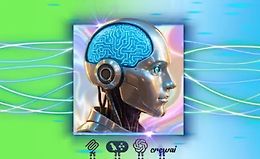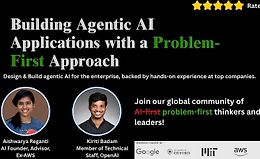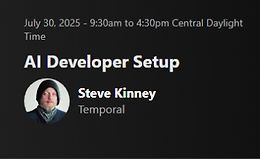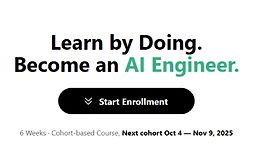Урок 1.
00:02:02
AI Engineering Bootcamp: Building AI Applications with LLM APIs, LangChain + much more!Using Jupyter Notebook
Урок 2.
00:09:24
Using Jupyter Notebook
Урок 3.
00:10:07
Using Virtual Environments (venv)
Урок 4.
00:08:50
Getting Started with the requests and httpx Libraries in Python
Урок 5.
00:04:39
Handling HTTP Errors
Урок 6.
00:09:59
Managing HTTP Authentication and Headers (OpenAI API)
Урок 7.
00:03:55
Setting Up the Environment: Jupyter Notebook and Pandas
Урок 8.
00:06:09
Introduction to Pandas: Series and DataFrames
Урок 9.
00:06:38
Importing and Exporting Data: Working with CSV Files
Урок 10.
00:07:47
Exporting Data to Different Formats: Excel, JSON, SQL, YAML
Урок 11.
00:06:05
Modifying Data: Adding and Dropping Columns and Rows
Урок 12.
00:05:43
Accessing Data: Using df.iloc[] and df.loc[]
Урок 13.
00:06:15
Sampling and Previewing Data: Using df.sample() and df.head()
Урок 14.
00:07:15
Filtering Data: Masks and pandas.Series.between()
Урок 15.
00:07:11
Sorting Data: Understanding Pandas Sorting Methods
Урок 16.
00:04:44
Handling Missing Data
Урок 17.
00:04:54
Aggregations and Grouping Data
Урок 18.
00:04:33
Project: Analyzing Website Traffic Data
Урок 19.
00:06:59
Time Series Data Manipulation in Pandas
Урок 20.
00:08:32
Foundations of LLMs and Generative AI
Урок 21.
00:05:26
Tokens, Context Windows and Cost
Урок 22.
00:09:23
Exploring LLM APIs: AI as a Service
Урок 23.
00:06:06
OpenAI Playground, Google AI Studio, and Anthropic Workbench
Урок 24.
00:09:03
Challenges and Limitations of LLMs
Урок 25.
00:10:06
The State of AI: Present and Future – The Good and the Bad
Урок 26.
00:06:41
Pretraining Data (Internet)
Урок 27.
00:06:07
Tokenization
Урок 28.
00:09:26
Training the Neural Network
Урок 29.
00:08:26
Post-Training: Supervised Fine-Tuning (SFT) and Reinforcement Learning (RL)
Урок 30.
00:05:30
Reinforcement Learning (RL)
Урок 31.
00:07:32
Becoming Better than Humans: AGI and ASI with RL
Урок 32.
00:06:23
Reinforcement Learning with Human Feedback (RLHF)
Урок 33.
00:07:37
How to Deal With Hallucinations
Урок 34.
00:07:49
Using Tools: Internet Search, Interpreter, and Deep Search
Урок 35.
00:09:51
Big Ideas Recap (Core Summary)
Урок 36.
00:08:17
Authenticating to OpenAI using Python Dotenv
Урок 37.
00:06:58
Chat Completions Endpoint
Урок 38.
00:04:31
Developer Message
Урок 39.
00:04:31
Streaming API Responses
Урок 40.
00:06:44
Using Local Base64 Images as Input
Урок 41.
00:02:05
Using Online Images as Input
Урок 42.
00:06:14
Chat Completion API Parameters: Temperature and Seed
Урок 43.
00:09:50
Chat Completion API Parameters: Top P, Max_Tokens, Penalties
Урок 44.
00:07:56
Diving into OpenAI’s Reasoning Models (o1 and o3)
Урок 45.
00:05:26
Best Practices for Prompting Reasoning Models
Урок 46.
00:05:48
Transcriptions with Whisper
Урок 47.
00:03:12
Translations with Whisper
Урок 48.
00:07:03
Text-to-Speech (TTS) API
Урок 49.
00:10:50
Generating Original Images Using the DALL-E 3
Урок 50.
00:03:05
Creating Variations of Images with DALL-E
Урок 51.
00:05:40
Editing Images with DALL-E
Урок 52.
00:02:41
Intro to Prompt Engineering
Урок 53.
00:04:13
Tactic 1: Position Instruction Clearly with Delimiters
Урок 54.
00:06:38
Tactic 2: Provide Detailed Instructions for the Context
Урок 55.
00:07:46
Tactic 3: Use the Rich Text Format (RTF)
Урок 56.
00:08:13
Tactic 4: Few Shot Prompting
Урок 57.
00:05:17
Tactic 5: Specify the Steps Required to Complete a Task
Урок 58.
00:02:13
Tactic 6: Give Models Time to Think
Урок 59.
00:05:38
Other Tactics and Principles for Better Prompting
Урок 60.
00:03:07
Avoid Hallucinations Using Guarding
Урок 61.
00:02:07
Summary
Урок 62.
00:02:32
Project Introduction
Урок 63.
00:05:39
Creating a Daily Meal Plan Using OpenAI API
Урок 64.
00:08:43
Creating the Prompt
Урок 65.
00:03:24
Running the Program
Урок 66.
00:11:54
Generating Original Images for the Recipes using DALL-E
Урок 67.
00:10:24
Narrate the Meals using the Text-to-Speech Model
Урок 68.
00:09:51
Setting Up the Python SDK and Authenticating for Gemini API
Урок 69.
00:04:15
Generating Text From Text Prompts
Урок 70.
00:02:59
Streaming Gemini Responses
Урок 71.
00:05:49
Generating Text From Images
Урок 72.
00:06:12
Gemini API Generation Parameters: Controlling How the Model Generates Responses
Урок 73.
00:10:14
Gemini API Generation Parameters Explained
Урок 74.
00:07:54
Building Chat Conversations
Урок 75.
00:07:19
Project: Building a Conversational Agent Using Gemini Pro
Урок 76.
00:05:43
System Instructions
Урок 77.
00:06:09
The File API: Prompting with Media Files
Урок 78.
00:06:42
Tokens
Урок 79.
00:04:21
Prompting with Audio
Урок 80.
00:05:54
Project Requirements
Урок 81.
00:05:23
Building the Application
Урок 82.
00:01:49
Testing the Application
Урок 83.
00:02:49
Streamlit: Transform Your Jupyter Notebooks into Interactive Web Apps
Урок 84.
00:11:20
Creating the Web App Layout With Streamlit
Урок 85.
00:05:20
Saving and Displaying the History Using the Streamlit Session State
Урок 86.
00:02:57
Exercise: Imposter Syndrome
Урок 87.
00:00:57
Project Introduction
Урок 88.
00:06:18
Getting Images Using a Generator
Урок 89.
00:09:35
Renaming Images Using Gemini
Урок 90.
00:05:06
LangChain Demo
Урок 91.
00:05:10
Introduction to LangChain
Урок 92.
00:08:43
Working with the OpenAI Models
Урок 93.
00:04:57
Caching LLM Responses
Урок 94.
00:02:58
LLM Streaming
Урок 95.
00:05:36
Prompt Templates
Урок 96.
00:05:55
ChatPromptTemplate
Урок 97.
00:07:48
Understanding Chains
Урок 98.
00:04:31
Installing the Python Libraries for Gemini and Authenticating to Gemini
Урок 99.
00:06:02
Integrating Gemini with LangChain
Урок 100.
00:06:32
Using a System Prompt and Enabling Streaming
Урок 101.
00:14:13
Multimodal AI With Gemini
Урок 102.
00:11:08
LangChain Tools: DuckDuckGo and Wikipedia
Урок 103.
00:13:30
Creating a React Agent
Урок 104.
00:04:50
Testing the React Agent
Урок 105.
00:03:16
Intro to OpenAI's Text Embeddings
Урок 106.
00:05:54
Generating Simple Embeddings
Урок 107.
00:04:52
Embedding the Dataset for Similarity Searches
Урок 108.
00:05:12
Estimating Embedding Costs With Tiktoken
Урок 109.
00:07:05
Performing Semantic Searches
Урок 110.
00:06:09
Project Introduction
Урок 111.
00:07:28
Loading Your Custom (Private) PDF Documents
Урок 112.
00:05:13
Loading Different Document Formats
Урок 113.
00:04:38
Public and Private Service Loaders
Урок 114.
00:06:39
Chunking Strategies and Splitting the Documents
Урок 115.
00:09:02
Intro to Vector Stores and Authenticating to Pinecone
Урок 116.
00:09:32
Working with Pinecone Indexes
Урок 117.
00:08:43
Working with Vectors
Урок 118.
00:06:44
Pinecone Namespaces
Урок 119.
00:13:53
Embedding and Uploading to a Vector Database (Pinecone)
Урок 120.
00:11:43
Asking and Getting Answers
Урок 121.
00:11:11
Using Chroma as a Vector DB
Урок 122.
00:09:26
Adding Memory to the RAG System (Chat History)
Урок 123.
00:08:10
Using a Custom Prompt
Урок 124.
00:04:20
Introduction to Agents and ReAct
Урок 125.
00:02:42
Creating the Agent Class
Урок 126.
00:02:31
Creating the ReAct Prompt
Урок 127.
00:02:41
Creating the Tools
Урок 128.
00:06:06
Testing the Agent
Урок 129.
00:07:01
Automating the Agent
Урок 130.
00:05:43
LangGraph Concepts and Core Components
Урок 131.
00:05:30
Building a Chatbot
Урок 132.
00:02:13
Visualizing the Graph
Урок 133.
00:01:32
Running the Chatbot
Урок 134.
00:08:29
Tavily AI
Урок 135.
00:08:17
Enhancing the ChatBot with Tools
Урок 136.
00:07:06
Adding Memory to the Chatbot
Урок 137.
00:02:14
Intro to Reflection
Урок 138.
00:04:16
Generate
Урок 139.
00:02:33
Reflect and Repeat
Урок 140.
00:03:44
Define the Graph - Part 1
Урок 141.
00:02:49
Define the Graph - Part 2
Урок 142.
00:03:55
Running the App
Урок 143.
00:03:29
Intro to LangSmith
Урок 144.
00:01:55
Setting Up LangSmith
Урок 145.
00:06:17
Tracing with LangSmith
Урок 146.
00:03:51
Tracing the Reflective Agentic App
Урок 147.
00:01:48
Project Overview
Урок 148.
00:07:39
Defining the Agent State and the Prompts
Урок 149.
00:09:39
Implementing Agents and Nodes
Урок 150.
00:01:27
Defining the Conditional Edge
Урок 151.
00:04:25
Defining the Graph
Урок 152.
00:04:07
Running the App
Урок 153.
00:02:51
Tracing the App with LangSmith
Урок 154.
00:02:16
Note
Урок 155.
00:03:34
Application Overview
Урок 156.
00:12:44
Extracting Data from ArXiv with Pandas
Урок 157.
00:04:53
Downloading Research Papers
Урок 158.
00:09:54
Loading, Splitting and Expanding Data
Урок 159.
00:05:35
Building a Knowledge Base for RAG
Урок 160.
00:07:17
Creating a Pinecone Index
Урок 161.
00:05:04
Loading the Knowledge Base and Deploying to Pinecone
Урок 162.
00:05:13
Developing Custom Tools
Урок 163.
00:08:01
Implementing the ArXiv Fetch Tool
Урок 164.
00:03:29
Unlocking Web Search with Google SerpAPI
Урок 165.
00:04:26
Building Google SerpAPI Tools
Урок 166.
00:06:20
Creating RAG Tools
Урок 167.
00:02:18
Implementing the Final Answer Generation Tool
Урок 168.
00:11:02
06_14 Initializing the Oracle LLM
Урок 169.
00:03:33
Testing the Ecosystem
Урок 170.
00:08:34
Building a Decision-Making Pipeline
Урок 171.
00:03:25
Defining the Agent State
Урок 172.
00:06:36
Defining the Graph
Урок 173.
00:04:27
Generating Reports
Урок 174.
00:05:20
Building the Final Research Report
Урок 175.
00:06:23
Concluding the Project
Урок 176.
00:06:17
Understanding Python Modules
Урок 177.
00:07:57
The OS Module
Урок 178.
00:04:11
Advanced Import Techniques and Best Practices
Урок 179.
00:06:24
Using __name__ == '__main__' for Modular and Reusable Code
Урок 180.
00:08:35
Mastering Python Package Management with pip
Урок 181.
00:01:18
Thank You!











































































































































































